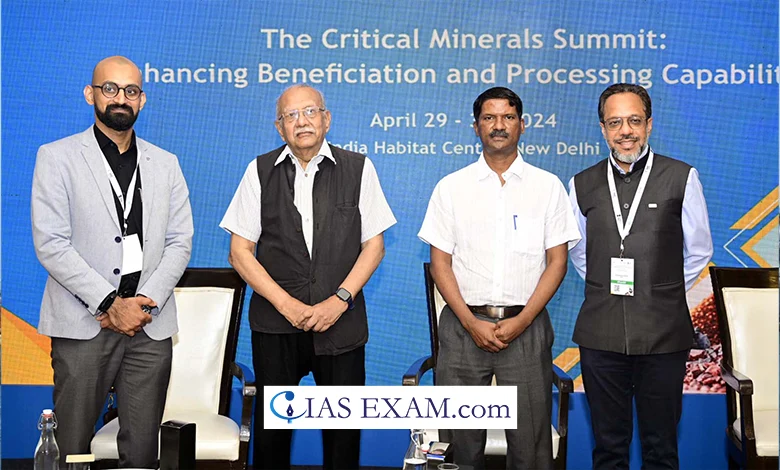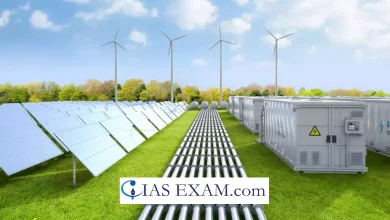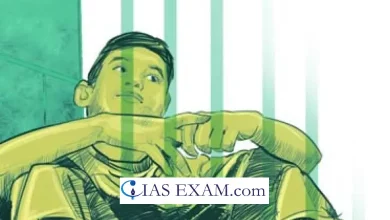Daily Current Affairs for UPSC
Critical Minerals Summit: Enhancing Beneficiation and Processing Capabilities
Syllabus - Economy [GS Paper-3]

Context
Recently the ‘Critical Minerals Summit: Enhancing Beneficiation and Processing Capabilities’ concluded in New Delhi.
Key Highlights
- It was organised by the Ministry of Mines in collaboration with the Shakti Sustainable Energy Foundation (Shakti), Council on Energy, Environment and Water (CEEW), and International Institute for Sustainable Development(IISD).
- The goal of the Summit was to equip government and industry stakeholders with the expertise, connections and tools essential to boost up the domestic manufacturing of Critical Minerals, assisting India’s financial growth.
About Critical minerals
- Critical minerals are those minerals that are critical for economic development and national security.
- The lack of availability of those minerals or concentration of extraction or processing in some geographical locations may additionally cause supply chain vulnerabilities or even disruption of substances.
- Government has launched a listing of 30 critical minerals for India.
- These minerals are Antimony, Beryllium, Bismuth, Cobalt, Copper, Gallium, Germanium, Graphite, Hafnium, Indium, Lithium, Molybdenum, Niobium, Nickel, PGE, Phosphorous, Potash, REE,Rhenium, Silicon, Strontium, Tantalum, Tellurium, Tin, Titanium, Tungsten, Vanadium,Zirconium, Selenium and Cadmium.
- The Government has similarly amended the Mines and Minerals Development and Regulation Act, 1957 (MMDR Act, 1957) thru the MMDR Amendment Act, 2023, whereby 24 essential and strategic minerals have been inserted in element D to the Schedule-I of the MMDR Act, 1957 which have been recognized as critical and strategic minerals for the country.
Importance
- The Indian economic system has passed through a transformative method of New Age reforms in the last decade.
- Critical minerals are the inspiration on which present day technology is built.
- Critical minerals are critical for the advancement of many sectors, such as hightech electronics, telecommunications, shipping, and defence.
- From sun panels to semiconductors, wind generators to superior batteries for garage and transportation, the world needs critical minerals to build these products.
- They also are essential to power the global transition to a low-emission economy, and the renewable strength technology so one can be required to satisfy the ‘Net Zero’ commitments of more and more nations around the sector.
Challenges
- One of the important challenges in the critical mineral supply chain lies in the global market dynamics that can result in rate volatility and supply disruptions.
- Technical difficulties in mineral extraction and the concomitant social and environmental impacts could extend the supply disruptions.
- India faces global and home demanding situations in assuring resilient critical minerals supply chains.
- The critical mineral supply chains may get affected because of the strategic partnership between China and Russia.
Related Steps
- The Ministry of Mines under its ‘Science and Technology Programme’ offers presents for Promotion of Research and Innovation in Start-united states and MSMEs in Mining, Mineral Processing, Metallurgy and Recycling Sector (S&T-PRISM).
- One of the thrust areas below S&T-PRISM consists of recognition of extraction of strategic and critical minerals at elemental degree.
- The Ministry is likewise actively engaged in different multilateral/ bilateral partnerships with diverse countries to secure the critical mineral demand of India.
- Under India’s G20 presidency, spotting the importance of the function of critical minerals in global power transition the Ministry of Mines was included in the G20 New Delhi Leaders’ Declaration.
- India became the 14th member of the Mineral Security Partnership (MSP) in June 2023.
- The different member nations are the United States, Australia, Canada, Finland, France, Germany, Italy, Japan, Norway, the Republic of Korea, Sweden, the UK and the European Commission.
- It seeks to bolster critical minerals supply chains to support financial prosperity and weather objectives.
- It seeks to make sure that vital minerals are produced, processed and recycled by means of catalyzing investments from governments and the personal region across the full value chain.
Conclusion and Way Forward
- India requires a critical minerals method to make the country Atma Nirbhar (self-reliant)due to the fact they’re needed for sustainable monetary increase and inexperienced technologies for climate action, national defence.
- Therefore it has turned out to be vital to discover and develop value chains for the minerals which are critical to our country.
- India ought to actively engage in bilateral and plurilateral arrangements for building confident and resilient critical mineral supply chains.
- Furthermore, the evaluation of critical minerals for India needs to be updated every 3 years to keep tempo with converting home and worldwide eventualities.
- To construct competitive cost chains in India, the invention of mineral wealth and figuring out regions of its capability by use of advanced technologies is essential.
- The reconnaissance and exploration of minerals must be recommended, with specific attention given to deep-seated minerals.
Source: The PIB
UPSC Mains Practice Question
Q.Despite India being one of the countries of Gondwanaland, its mining industry contributes much less to its Gross Domestic Product (GDP) in percentage. Discuss. (2021)





.png)



